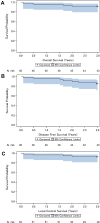Clinical Outcomes of Proton Beam Therapy for Ground-Glass Opacity-Type Lung Cancer
- PMID: 33117018
- PMCID: PMC7553652
- DOI: 10.2147/LCTT.S270283
Clinical Outcomes of Proton Beam Therapy for Ground-Glass Opacity-Type Lung Cancer
Abstract
Purpose: Surgery is the standard treatment for early-stage non-small cell lung cancer (NSCLC), including ground-glass opacity (GGO)-type lung cancer. However, some patients are inoperable or refuse to undergo surgery. To explore whether proton beam therapy (PBT) can be an alternative to surgical resection in these patients, this study aimed to examine the retrospective treatment outcomes of patients with GGO-type lung cancer who underwent PBT.
Patients and methods: Patients with stage I NSCLC and GGOs who underwent PBT at the Medipolis Proton Therapy and Research Center (Kagoshima, Japan) between April 2011 and September 2015 were included. Patients were treated with a total dose of 66 GyE delivered in 10 fractions. Survival curves were calculated using the Kaplan-Meier method, and treatment-related adverse events (AEs) were assessed.
Results: A total of 48 patients (median age: 70.9 ± 9.2 years; men: 54.2%) were analyzed, among whom 53 tumors were observed. The 3-year overall survival rate after PBT was 91.7% (95% confidence interval [CI], 79.3-96.8%), the 3-year disease-free survival rate was 85.4% (95% CI: 71.8-92.8%), and the 3-year local control rate among 53 tumors was 92.5% (95% CI: 81.1-97.1%). During the 3-year follow-up period, 4 patients died, and 3 survived despite recurrence or metastasis. Common AEs were radiation pneumonitis (89.6%), rib fracture (27.1%), and cough (27.1%). None of the patients developed grade ≥3 treatment-related AEs.
Conclusion: The results of this study suggest that PBT may be a promising alternative for patients with GGO-type lung cancer when surgical resection is not feasible, with excellent survival outcomes and tolerable treatment-related AEs.
Keywords: Japan; adenocarcinoma; carcinoma; ground-glass opacity; non-small-cell lung; proton therapy.
© 2020 Nagata et al.
Conflict of interest statement
The authors declare that they have neither conflict of interest nor financial support.
Figures
References
-
- Cancer Registry and Statistics. Cancer information service, national cancer center, Japan, cancer mortality (1958‒2017). n.d.. Available from: https://ganjoho.jp/en/professional/statistics/table_download.html. Accessed June22, 2020.
-
- The Japan Lung Cancer Society. Practice guidelines for lung cancer 2018, n.d.. Available from: https://www.haigan.gr.jp/guideline/2018/1/2/180102010100.html. Accessed February13, 2019.
-
- Iwata H, Murakami M, Demizu Y, et al. High-dose proton therapy and carbon-ion therapy for stage I nonsmall cell lung cancer. Cancer. 2010;116(10):2476–2485. - PubMed
LinkOut - more resources
Full Text Sources
Miscellaneous


